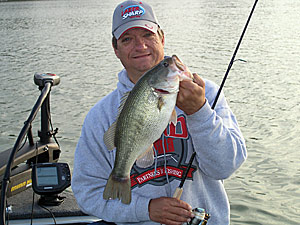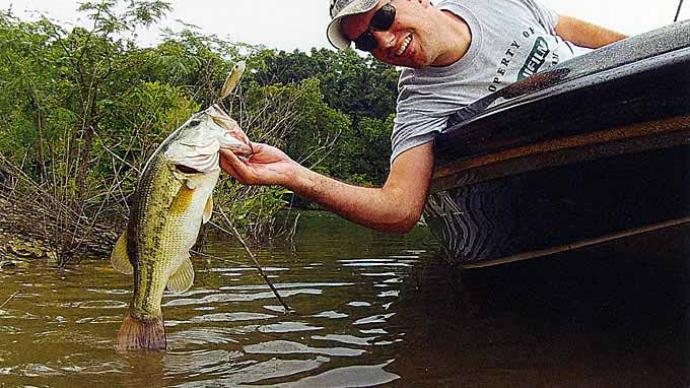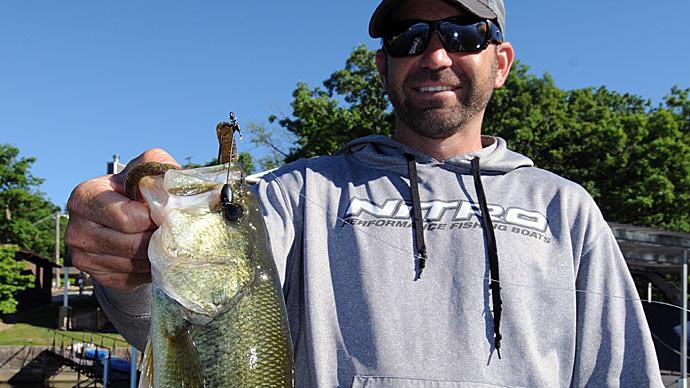
When it comes to catching bass, you have a ton of presentations to choose from. For those of you who like to power fish, you can throw spinnerbaits or maybe crankbaits, but when the bass get a little tight-lipped, what do you turn to to get bass over the side of your boat? Lighten up a little. Finesse bassin holds the key to success when the bite gets tough.
If you follow any of the Bassmaster tournaments, you see some big names trading baitcasting gear for spinning gear and downsizing to get bites and, in some cases, win a few tournaments along the way. Most top pros have won tournaments or finished in the top three on the Elite series using finesse tactics and presentation.
Most of the finesse fishing up in the Midwest was formed around a jig head. Outkast's Tackle Money Jig fits this base jig pattern well. The Money Jig comes in 4 different sizes 1/16 ounce, 3/32 ounce, 1/8 ounce, and 3/16 ounce. What you tip the jig with has a lot to do with the pattern or structure you're fishing.
In the spring, the bass will make movements towards the shallows to put on the spring feed bag and prepare for the spawn. This is the time to pay attention to the inside weed line starting to take shape. Bass are edge creatures and will use this inside weed line as a path to get from one area to another or will move up and down this inside weed lines to feed. I generally rig a jig with a few different options for this bite. One is to put the jig inside of a tube head; another presentation is to rig a Stickworm on the jig.
One important point to pay attention to is targeting inside weed lines located off the shoreline. Inside weed lines located a distance from the shore will hold more bass early in the season than inside weed lines located next to the shore. Boat positioning is critical when fishing this pattern. You want to position your boat to cast parallel to the weed line. This keeps your bait in the strike zone longer than if you position your boat away from the weed line and cast up to it and make your retrieve.
Bass will reside in deeper water and on the outside weed line as the season moves along. To be successful, you will have to move with them. When bass are active, they will be positioned on top of the weeds roaming and looking for food. But when they are inactive, they will position themselves down in the weeds or at the base of the weeds on the outside edge of the weed line.
The best choices for tipping the jig, in this case, will be 4-inch worms. I prefer to use ringworms. Another bait choice is a wide tail grub, especially when fishing during cold front conditions. The oversized tail of the grub gives the jig a slower fall than a jig and worm combo, especially when bass are in a neutral, non-active mood. Many times this has been the bait combination that has saved the day for me when I needed one last fish to make out a tournament limit.
Other options when targeting outside weed lines include tubes and the Stick Worm. When fishing this presentation, you're best to use two boat positions. If the bass are active and on top of the weeds feeding, it's best to position your boat within casting distance of the edge of the weeds and make casts to the edge taking advantage of the active bass. If the bass are inactive, position your boat and cast parallel to the weed line, getting your bait to the base of the weeds and working it back to the boat. This keeps your bait in the strike zone longer, giving you a better chance to catch fish.
During the hot summer months, you have a school of bass that moves to the deep rocks. This is the home of big bass, but one factor comes with this - the cover factor. Because of the lack of cover, they don't have any cover to hide in, so these bass adjust to weather changes by either heading towards deeper water or sitting in the rocks and shut off big time.
One of the best baits I have used to get bass to bite during these conditions is a jig tipped with a spider grub. Cast the bait out and let it settle to the bottom. When the jig hits bottom, slowly drag this bait along the bottom. You don't want to hop this bait unless the bass are active and feeding. By dragging the bait on the bottom, you're imitating a crawfish trying to escape from the bass' sight slowly. You know what? This drives them crazy, to think that little crawfish is trying to act sly and escape. I think they tell themselves, "I'll show him I'll just eat'em."
Finesse fishing is mainly done on a spinning setup. I prefer to use a 7-foot medium-action spinning rod teamed up with a matching reel, spooled with either 6-pound or 8-pound mono line. With today's improvement in fluorocarbon line from a couple of years back, you can get by fishing these presentations with fluorocarbon line on a spinning setup.
We have two sides in bass fishing: power fishing and finesse fishing. Each works in its own right. But when the bite gets extra tough, don't be afraid to tie on a jig, downsize your bait size, and fish slower. Tipping the Money Jig with various baits like tubes, spider grubs, stick worms, and ringworms, you will soon see the finesse side of fishing will take big bass and numbers of bass along the way.
So when the bite slows down for you next time, don't be afraid to give finesse tactics a try. Who knows? You just may become a dedicated fisherman of the jig like many of us.




